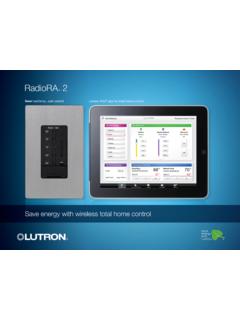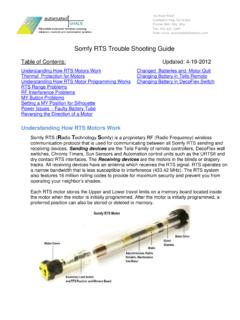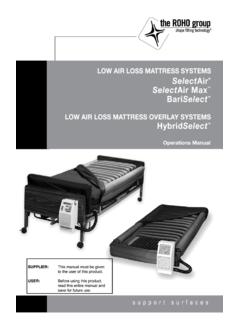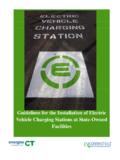Transcription of Centaur Installation Guide - ANZ Region
1 Guide 2 Edition 7 SydneyCentaur Alarm Signalling EquipmentCentaurInstallation GuideGuideGuide 2 Edition 7 SydneyADT FIRE MONITORINGADT FIRE MONITORINGADT FIRE MONITORINGADT FIRE MONITORINGC entaur Installation Guide105 Highbury Rd Burwood. 3125 Phone +613 9211 1161 Fax +613 9211 2930 Alarm Enquiries 1300 360 575 ASE Conversion +613 9805 8889 Centaur ANSWERING YOUR CALL - Guide 2 Edition 7 SydneyTable of ContentsABOUT THE Installation GUIDES3 ABOUT THE CENTAUR3 GENERAL RF THEORY41. Digital Radio Network42. Mobitex43.
2 Frequency of Operation54. Signal Strength55. Hardwire RF Losses76. About Antennae8 INSTALLATION111. Pre- Installation Monitoring Requirements. Examples153. Installing The ASE164. Antenna ASE wiring20A. Introduction20B. Connection Of A Fire Indicator Panel To The Centaur ASE20 ASE Threshold Voltages as Measured at the ASE s I/P Terminals22C. Connection Of An Alarm System with Alarm Outputs Only23D. Power Supply Connection24E. About the Power Supply25F. Open Collector Outputs26G. PSTN Connection27H.
3 RF TNC Up and ASE Status Indicators29 Centaur ANSWERING YOUR CALL Guide 2 Edition 7 Sydney8. Operating the ASE30A. Normal Operation30B. Key Insertion31C. Isolate Mode31D. Test Mode32E. RSSI Mode33F. Key Removal & Timeout33G. Daily Test33H. ASE Number339. Installation CHECKLIST34 COMPLIANCE TO STANDARDS37 GLOSSARY OF TERMS38 DISCLAIMER38 APPENDIX A39 Centaur Specification39 Electrical39 Physical39 Environmental39 Approvals39 Centaur ANSWERING YOUR CALL Page 3333 Guide 2 Edition 7 Sydney20/11/2000 About the Installation GuidesThe ADT Installation Guide is available two Centaur Installation Guide is available two ways.
4 Guide 1 steps through the entireinstallation and commissioning procedure in an abbreviated form. It is aimed at theinstallation technician who has installed a number of Centaur Alarm SignallingEquipment (ASE) units, is familiar with radio frequency (RF) theory and theadditional information presented in Guide the CentaurThe Centaur is self-contained Alarm Signalling Equipment (ASE) which monitors up tosix alarm systems (either fire detection or fire suppression), and sends alarm, fault andisolation information to ADT Fire Monitoring s Control and Monitoring System (CMS).
5 It communicates through a radio link and/or conventional dial-up telephone line. Wheninstalled with a radio, the radio is the primary communications link and the telephoneline is configured as a backup link or secondary communications linkGuideICON KEYF urther Readingfrom Part 1* Please NoteN WarningTCustomer Care CentreASE NoTel: 1300 36 0575 ASE INPUTALARM TYPEALARM SYSTEM STATUSASE INPUT STATUSASE STATUSN ormal OperationAlarm System Test ProcedureASE Isolate ProcedureActionASE TEST MODEALARMA ctionASE ISOLATEPOWERFAULTCOMMSASE ISOLATEASE TEST MODEWIRING FAULTISOLATEFAULTALARM1234651 Insert Test Key2 Activate Alarm3 Reset Alarm4 Remove Test KeySlow Flash OnOnOnSlow Flash OffOffSlow Flash OnSlow Rapid FlashRapid Flash OffCOMMS and POWER On SteadyInsert Isolate KeySlow Flash OnCENTAUR ANSWERING YOUR CALL
6 Page 4444 Guide 2 Edition 7 Sydney20/11/2000 General RF Theory1. Digital Radio NetworkCentaur communicates with the ADT CMS via a Mobitex Digital Radio Packet network asits primary Digital Radio Packet network carries digital data over an analogue medium, there are radio systems capable of carrying both voice and data, the system chosenby ADT Fire Monitoring is optimised for carrying data MobitexMobitex is a radio network technology designed exclusively for two-way, wireless datacommunications (see Figure 1).
7 The technology, developed by Swedish Telecom, hasbeen in use for over 13 years. Mobitex networks are operating in 14 countries, includingAustralia, Belgium, Canada, the Netherlands, the United Kingdom, the United States ofAmerica, Sweden and FireMonitoringFigure 1: Typical Mobitex Network StructureThe Mobitex network has a hierarchical (or pyramidal) network intelligent base station serves each radio device (ASE) and host (CMS) attached to a Mobitex network is assigned a uniqueMobitex Access Number (MAN). The Mobitex protocol guides digital data, formed intopackets, from the ASE to the CMS and vice-versa.
8 All packet transmissions are checkedfor integrity prior to passing to the next stage. Automatic error correction and re-transmission of data may occur as the result of borderline radio signal ANSWERING YOUR CALL Page 5555 Guide 2 Edition 7 Sydney20/11/20003. Frequency of OperationThe frequency band used by the radio system is in the range 400 to 420 Megahertz (MHz).This has several implications: The wavelength of the RF carrier is approx. 730mm. The majority of antennae used withthe ASE units will be wave antennae or least 365mm long.
9 The radio communications path between the ASE antenna and the radio base antennashould, if possible, be line of sight . There should be few, and ideally no obstaclesbetween the ASE antenna and the base site optical line of sight in the open is not quite possible (just out of sight), it can still bepossible to obtain reliable communications with the base because of a naturalphenomenon known as diffraction. Diffraction (or bending) of radio waves allowscommunications between two antennae which are in an almost line of sight condition(see Figure 2).
10 Diffraction allows an increase of approx. 20% extra distance over theoptical line of sight .Figure 2: The RF waves bend downward over the top of the mountain towards theground As the frequency of radio waves increases, so does the inability of an RF signal topenetrate a building. At 410 MHz the RF signal is attenuated to a greater extent insidebuildings than, for example, the frequency of Broadcast FM radio at about 100 , the signal strength is attenuated to a lesser extent inside a building than forexample a mobile telephone operating at 900 Signal StrengthSignal strength is the measure in dBuV/m (decibel microvolts per metre) of the strength of aradio frequency signal.






